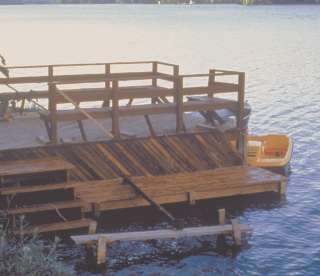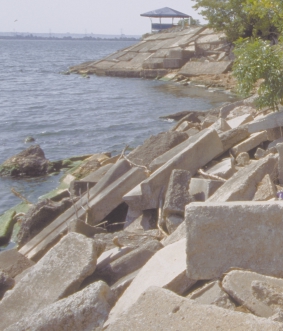|
Home  Infocentre Infocentre  Guidelines & Factsheets Guidelines & Factsheets  Factsheets - Saskatchewan Factsheets - Saskatchewan
Saskatchewan Fact Sheet 3
What You Should Know About Fish Habitat and Building Materials
This fact sheet provides information about the use of different building materials
for in-water works.
Recently there have been a number of changes in the way proposals for in-water
works are reviewed. These changes are outlined in the introductory fact sheet,
Working Around Water? What You Should Know About Fish Habitat. This introductory
fact sheet introduces the entire Working Around Water? series of fact sheets
that are designed to help in the planning of different types of in-water works.
Be aware of the Fisheries Act and other legislation
The federal Fisheries Act provides for the protection of fish habitat. Under
this Act, no one may carry out  any work that harmfully alters, disrupts
or destroys fish habitat, unless authorized by Fisheries and Oceans Canada.
The Act also states that no one is permitted to deposit a deleterious (harmful)
substance into water containing fish. Violations can result in substantial
fines, the risk of imprisonment and a requirement to cover the costs of
returning
the site to its original state. Other legislation that may be relevant
is outlined
in the introductory fact sheet: Working Around Water? What You Should Know
About Fish Habitat. any work that harmfully alters, disrupts
or destroys fish habitat, unless authorized by Fisheries and Oceans Canada.
The Act also states that no one is permitted to deposit a deleterious (harmful)
substance into water containing fish. Violations can result in substantial
fines, the risk of imprisonment and a requirement to cover the costs of
returning
the site to its original state. Other legislation that may be relevant
is outlined
in the introductory fact sheet: Working Around Water? What You Should Know
About Fish Habitat.
This fact sheet provides information for property owners planning to use building
materials for construction projects in or around water. Certain materials can
adversely affect water quality and are harmful to fish or fish habitat. Others
can reduce natural habitat diversity by replacing natural shorelines and substrates
with less diverse man-made structures. This fact sheet contains a number of
tips for selecting "fish friendly" materials for construction in
or around water.
In addition, it is a good idea to talk to local contractors, engineers and
building supply outlets to ensure that all aspects of your project are completed
properly. Most contractors can usually recommend building materials that are
attractive, long-lasting and will not harm fish, fish habitat or water quality.
Soft Structures (Bioengineering)
Bioengineering is an approach to stabilizing exposed soils that uses natural
materials (logs, rocks, live stakes, live brush bundles etc.) in combination
with plants. It is used to stabilize banks and shorelines, enhance habitat
and other similar applications. A bioengineered structure has a natural appearance
and can provide additional habitat for fish. In general, any approach that
uses natural materials such as wood, rocks and shrubs when building structures
in or near water is better than hard approaches using materials such as concrete,
steel or plastics. Avoid using concrete, steel and plastics to stabilize slopes
as these materials provide little habitat for fish and other aquatic organisms.
Reused and recycled materials 
While efforts to reduce, reuse and recycle materials can generally provide
environmental benefits, old materials (e.g. creosote treated railway ties,
old metal drums, tires, or car parts) are not recommended for any shoreline
or in-water works. These materials are known to release poisons, oils, grease
or other chemical substances that are toxic to humans, fish and other forms
of wildlife.
Untreated wood
Wood is a common material for docks, swim platforms, etc. It’s relatively
easy to work with, reasonably priced, and has some "give," allowing
it to bend slightly under duress. Types of wood to consider are western red
cedar, redwood, cypress, and eastern white cedar (in that order), which all
offer reasonable longevity and beauty. These woods have natural preservatives
that protect them from the rotting that result from repeated water exposure
and air-drying.
For dock cribs and permanent piles, stronger woods, such as Douglas fir, hemlock,
and tamarack (in that order) are good choices. Unfortunately, this group is
not as resistant to rot as the first. For permanent piles, western larch, pine,
and even spruce can be used if fir, hemlock or tamarack is not available.
The standard methods for preserving wood - paint and stain - are not the answer
for projects in and around water. For example, any coating put on a dock will
fade, blister and peel. These damaged coatings then trap water, creating an
ideal spot for wood-destroying fungi. The alternative to scraping and re-coating
the dock every few years is to use a preferred wood species and let the wood
go naturally grey.
Treated wood
Pressure-treated pine or spruce is considerably less expensive than the preferred
decking species, such as cedar, but because the grades of lumber set aside
for treatment are usually low, pressure-treated wood is typically more
susceptible to warping and cracking when exposed to weather than the preferred
untreated
species.
Because pressure-treated wood can leach chemicals into the environment, the
use of these products should be used with caution and avoided if possible.
Working with pressure-treated wood is more difficult, the sawdust is considered
toxic, and each cut end must be sealed with an approved preservative. Organic
wood preservatives (e.g. creosote, PCP) should not be used on structures placed
in or near water. Efforts should be made to buy products that are manufactured
according to Best Management Practices (wood products will bare a BMP stamp).
All wood preservatives used today contain compounds that are poisonous to
fungi and should be used with care. If you use treated wood or apply preservatives
yourself, be sure to read the label carefully and take all precautions suggested
by the manufacturer.
Metals
Steel structures are generally not recommended for use in or near water,
particularly where they form solid, vertical structures. Solid vertical
structures provide
little in the way of habitat for fish and other aquatic organisms. In some
situations however, they may be the only appropriate material to use. Unpainted
steel can rust and detract from the appearance of your shoreline although
it has little effect on water quality. Painted steel should be avoided
for use
in the water because paint flakes can be toxic to aquatic organisms, such
as fish. Where metal retaining walls extend below the average annual high-water
mark, approvals are required. Contact Fisheries and Oceans Canada and your
local Saskatchewan Environment and Resource Management field office. Stainless
steel, galvanised steel or bronze fittings are often more expensive than
steel,
but last longer.
Concrete
Solid, vertical concrete structures provide little or no habitat for fish
and other aquatic organisms and are generally not recommended for use
in or near
water. However, concrete may be the only appropriate material for use
in some situations. If you must use concrete in your structures you will
find
it difficult
to get approvals. It is recommended that you get professional advice
during the construction and planning of concrete structures.
If concrete is used for walls in contact with water, watertight forms should
be constructed so that concrete is poured into a dry cavity and does not spill
into the water. As concrete cures it changes the water chemistry and may result
in a fish kill. When it has set, concrete is not harmful to water quality and
can be used for structures such as blocks for anchoring floating docks and
swimming platforms. Where concrete is covering areas below the average annual
high-water mark of any waterbody, approvals are required. Contact Fisheries
and Oceans Canada.
Plastic (used for flotation)
Plastic has become a common building material for docks, particularly for
flotation. Most plastic materials will not affect water quality. They are
tough and float
well when sealed but can deteriorate over time from exposure to wind, waves
and ultraviolet light. Visit your local building supply outlet to determine
the best type  of plastic for your project. Plastic flotation materials
are available in many shapes, sizes and colours and are ideal for making
floating
docks and swimming platforms. of plastic for your project. Plastic flotation materials
are available in many shapes, sizes and colours and are ideal for making
floating
docks and swimming platforms.
Plastic may also be used for the decking of a dock. Although it lacks strength,
when supported by a wooden foundation, plastic decking can be appropriate given
its waterproof and decay-resistant properties.
Polystyrene
Polystyrene (plastic foam) has little effect on water quality. However, some
forms of polystyrene, particularly white expanded polystyrene, break down
over time. This can be hazardous for fish and other aquatic organisms as
they may
try to ingest small pieces, mistaking them for food.
For flotation devices in docks, boathouses or swimming platforms, the blue
or pink closed-cell extruded polystyrene billets are recommended. The billets
should be wrapped in polyethylene sheeting to protect them from accidental
gasoline spills.
Working together to protect fish
Help maintain the quality of fish habitat in our lakes and streams. Please
contact agency staff before beginning any work in or around water.
For further information or to obtain copies of other fact sheets in this series,
contact:
Fisheries and Oceans Canada, Regina District
1804 Victoria Ave East
Regina, SK S4N 7K3
Phone (306) 780-8725; Fax (306) 780-8722
Fisheries and Oceans Canada, Prince Albert District
125-32nd Street West
Prince Albert, SK S6V 7H7
Phone: (306) 953-8777; Fax: (306) 953-8792
Federal and provincial offices are listed in your phone book under Government
of Canada and Government of Saskatchewan.
Cette publication est également disponible en français
Version 1.0 February 2002
|